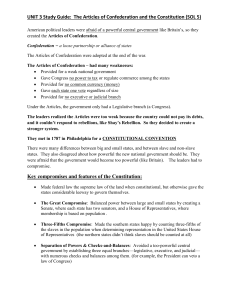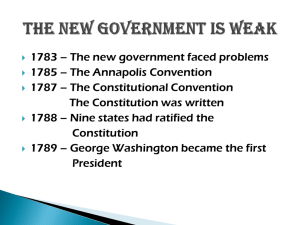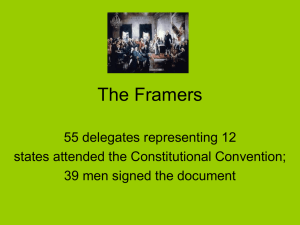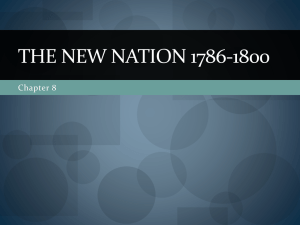The Constitutional Era
advertisement
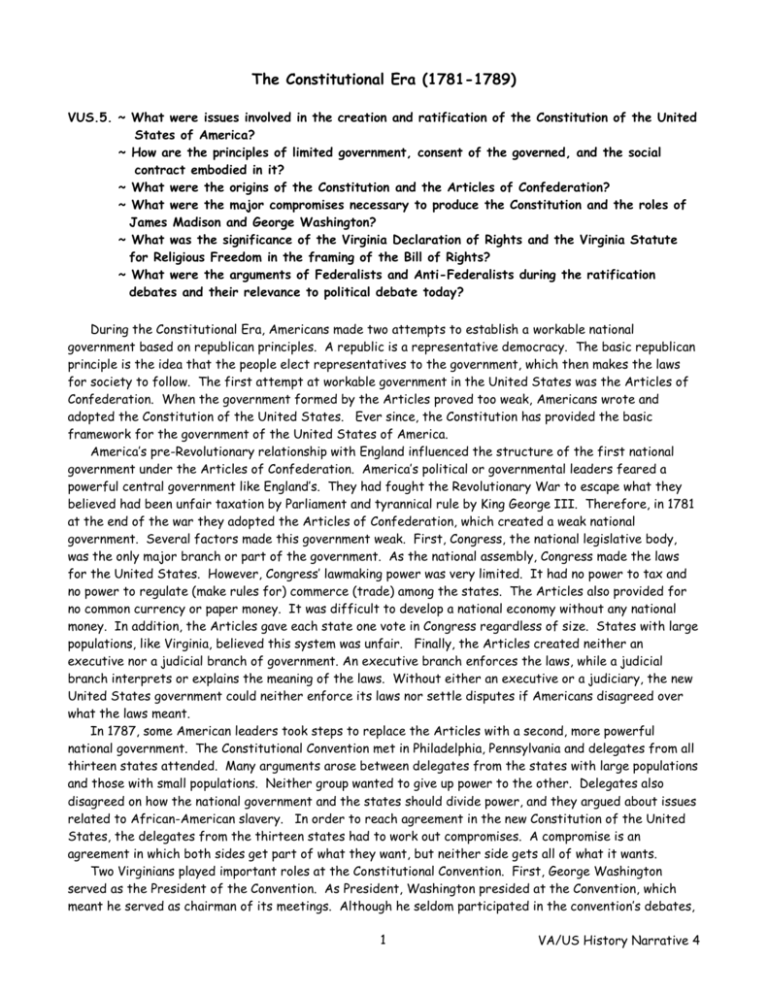
The Constitutional Era (1781-1789) VUS.5. ~ What were issues involved in the creation and ratification of the Constitution of the United States of America? ~ How are the principles of limited government, consent of the governed, and the social contract embodied in it? ~ What were the origins of the Constitution and the Articles of Confederation? ~ What were the major compromises necessary to produce the Constitution and the roles of James Madison and George Washington? ~ What was the significance of the Virginia Declaration of Rights and the Virginia Statute for Religious Freedom in the framing of the Bill of Rights? ~ What were the arguments of Federalists and Anti-Federalists during the ratification debates and their relevance to political debate today? During the Constitutional Era, Americans made two attempts to establish a workable national government based on republican principles. A republic is a representative democracy. The basic republican principle is the idea that the people elect representatives to the government, which then makes the laws for society to follow. The first attempt at workable government in the United States was the Articles of Confederation. When the government formed by the Articles proved too weak, Americans wrote and adopted the Constitution of the United States. Ever since, the Constitution has provided the basic framework for the government of the United States of America. America’s pre-Revolutionary relationship with England influenced the structure of the first national government under the Articles of Confederation. America’s political or governmental leaders feared a powerful central government like England’s. They had fought the Revolutionary War to escape what they believed had been unfair taxation by Parliament and tyrannical rule by King George III. Therefore, in 1781 at the end of the war they adopted the Articles of Confederation, which created a weak national government. Several factors made this government weak. First, Congress, the national legislative body, was the only major branch or part of the government. As the national assembly, Congress made the laws for the United States. However, Congress’ lawmaking power was very limited. It had no power to tax and no power to regulate (make rules for) commerce (trade) among the states. The Articles also provided for no common currency or paper money. It was difficult to develop a national economy without any national money. In addition, the Articles gave each state one vote in Congress regardless of size. States with large populations, like Virginia, believed this system was unfair. Finally, the Articles created neither an executive nor a judicial branch of government. An executive branch enforces the laws, while a judicial branch interprets or explains the meaning of the laws. Without either an executive or a judiciary, the new United States government could neither enforce its laws nor settle disputes if Americans disagreed over what the laws meant. In 1787, some American leaders took steps to replace the Articles with a second, more powerful national government. The Constitutional Convention met in Philadelphia, Pennsylvania and delegates from all thirteen states attended. Many arguments arose between delegates from the states with large populations and those with small populations. Neither group wanted to give up power to the other. Delegates also disagreed on how the national government and the states should divide power, and they argued about issues related to African-American slavery. In order to reach agreement in the new Constitution of the United States, the delegates from the thirteen states had to work out compromises. A compromise is an agreement in which both sides get part of what they want, but neither side gets all of what it wants. Two Virginians played important roles at the Constitutional Convention. First, George Washington served as the President of the Convention. As President, Washington presided at the Convention, which meant he served as chairman of its meetings. Although he seldom participated in the convention’s debates, 1 VA/US History Narrative 4 he lent his enormous prestige (respect) to the proceedings. Since all Americans respected George Washington, they figured if he would serve as President of the Convention, then it must be a good thing for the United States to create a new government. Second, James Madison, a brilliant political philosopher, often led the debate and kept very thorough notes of the proceedings. Madison’s notes are the best record historians have of what occurred at the Convention. Madison proposed many of the basic ideas eventually included in the Constitution. For example, he authored the “Virginia Plan,” which proposed a federal government of three separate branches and became the foundation for the structure of the new government. Because of the leadership, James Madison provided at the Constitutional Convention, he has become known as “Father of the Constitution.” The Constitution of the United States of America established a government that shared power between the national government and state governments, protected the rights of states, and provided a system for orderly change through amendments or additions to the Constitution itself. The distribution of power between a central or national government and its political subdivisions (the states) is called federalism. The Constitution also made federal (national) law the supreme law of the land when constitutional. This means whenever a state law conflicts with a national law, then the national law wins out and becomes the law for the entire country. The part of the Constitution that expresses this idea is called the supremacy clause. The supremacy clause states the Constitution is the supreme law of the land and is therefore binding on the state courts. However, the Constitution did allow the states to keep considerable leeway (flexibility) to run their own governments. Disagreement between the large states and the small states developed at the Constitutional Convention regarding the states’ representation in the national legislature. Under the “Virginia Plan,” the national lawmaking body consisted of a two-house legislature or congress. Since the “Virginia Plan” provided that population determine representation in both houses of congress, it would greatly reduce the influence of the smaller states and give the more populous and wealthy states, like Virginia, Massachusetts and Pennsylvania, control over the national legislature. The small states flatly rejected this part of the “Virginia Plan.” They countered with the “New Jersey Plan,” which provided for equal representation for each state in the national legislature. The “New Jersey Plan” said each state would possess one vote in Congress, to preserve the principle of state equality. After considerable discussion, the delegates to the Constitutional Convention agreed on the Great Compromise. Under the Great Compromise, Congress consists of a two-house legislature. Each state, regardless of its size, gets two members in the Senate, while population determines a state’s membership in the House of Representatives. For example, today California and Wyoming each have two United States senators. California with a very large population has fifty-five members in the House of Representatives, while Wyoming, which has a very small population, has only one representative in the House. In short, the Great Compromise provided for a two-house Congress in which the people would be represented in a House of Representatives and the states in a Senate. Thereby, the Great Compromise balanced power between large and small states in Congress. An argument arose at the convention between the northern and southern states. All the northern states had decided to abolish or end slavery in the years immediately following the Revolution, because they recognized that African-American slavery contradicted the Declaration of Independence’s idea that “all men are created equal.” However, the white leaders of the southern states had decided to keep slavery, because they believed it brought them economic prosperity. Unfortunately, financial greed and racial prejudice were more important to the southerners than their political ideals. The northern states said that since slaves were property instead of citizens, they should not be counted when determining the slave states’ membership in the House of Representatives. The southerners argued that since slaves were human beings, they should be counted in figuring a state’s population for representation in the House. The two regions eventually compromised by counting each slave as three-fifths of a person. This agreement became known as the three-fifths compromise, which succeeded in placating (satisfying) the Southern states. 2 VA/US History Narrative 4 Americans were still nervous about making the central or national government too powerful. James Madison answered this concern by proposing in the Virginia Plan a federal government of three separate branches, which divided power and governmental responsibilities. The division of power among different branches of government is known as separation of powers. Madison created three separate, but co-equal, branches. These three branches are the legislative, executive, and judicial. The legislative branch or Congress makes the laws. The executive branch, led by the President, enforces the laws. The judicial branch, led by the Supreme Court, interprets or explains the meaning of the laws. Madison also included in the Constitution a checks and balances system so that none of the three branches would become too powerful. Checks and balances is a system by which each branch of government can check or stop the actions of the other branches. For example, under the Constitution, the President appoints the members of the Supreme Court, but the Senate must confirm or approve these appointees before they can become Supreme Court justices. Finally, the Constitutional Convention tried to restrain or check the federal government’s power by limiting it to those powers specifically identified in the Constitution. Before the new Constitution could take effect, at least nine states had to ratify or approve it. The ratification debate in Virginia was pivotal, because Virginia was the largest state in population and was located on the Atlantic seaboard in the very center of the nation. Two groups of Americans emerged the Federalists, who supported ratification, and the Anti-Federalists, who opposed it. The Federalists advocated (supported) the importance of a strong national government, especially to promote economic development and public improvements. For example, a strong national government could promote public improvements by using federal tax money to build roads and canals. By improving the nation’s transportation system, such public improvements could lead to the expansion of the American economy. George Washington and James Madison were the leading Federalists or proponents (supporters) of ratification in Virginia. In contrast, the Anti-Federalists feared an overly powerful central or national government, because they believed it would destroy the rights of individuals and the prerogatives (rights or privileges) of the states. Patrick Henry and George Mason were Virginia’s two leading opponents of ratification. AntiFederalists, like Henry and Mason, also believed that a national Bill of Rights was necessary. During the ratifying conventions in several states, the Anti-Federalists forced the Federalists to pledge that a Bill of Rights would be the first order of business of the new government established by the Constitution. Eventually, all thirteen states ratified or approved the Constitution and it took effect in 1789. James Madison, who had been one of the Federalists’ leaders during the ratification process, took responsibility for drafting (writing) a Bill of Rights, which would meet the Anti-Federalists’ concerns without weakening the new government. The major principles of the Bill of Rights of the Constitution were based on earlier Virginia statutes (laws). While drawing up the amendments that eventually became the United States Bill of Rights, Madison consulted (looked at) the Virginia Declaration of Rights and the Virginia Statute for Religious Freedom. George Mason, one of Virginia’s political leaders, had written the Virginia Declaration of Rights. This document set forth the idea that governments should not violate basic human rights. Thomas Jefferson had written the Virginia Statute for Religious Freedom. This document outlawed the established church in Virginia. Under British colonial rule, the Anglican Church had been the established church, which was the practice of the colony giving government support to one favored church. In short, the Virginia Statute for Religious Freedom supported the idea of freedom of religion. The states then ratified the Bill of Rights, which meant it was added to the Constitution. The Bill of Rights is the first ten amendments to the Constitution. An amendment is an addition to the Constitution. The First Amendment guarantees all Americans freedom of speech, freedom of the press, freedom of religion, freedom of assembly (the right to gather at public meetings), and the right of petition (the right to make written requests to make changes in the government). Ratification of the Constitution did not end debate on the issue of governmental power. Elements of Federalist and Anti-Federalist thought are reflected in contemporary political debate on issues such as the size and role of government, federalism, and the protection of individual rights. In other words, political 3 VA/US History Narrative 4 leaders today debate some of the same topics that divided the Federalists and the Anti-Federalists more than two hundred years ago. Those Americans, who see a primary role for the federal government in solving national problems, are heirs to the Federalists’ beliefs. Americans, who hold more conservative beliefs, echo the concerns of the Anti-Federalists and champion liberty, individual initiative, and free markets (business and trade without government regulation or rules). 4 VA/US History Narrative 4

